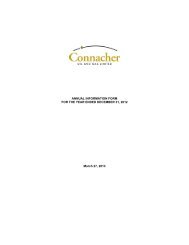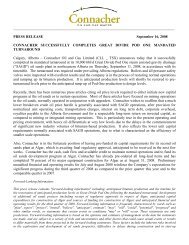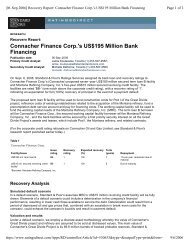ANNUAL REPORT 2011 - Connacher Oil and Gas
ANNUAL REPORT 2011 - Connacher Oil and Gas
ANNUAL REPORT 2011 - Connacher Oil and Gas
You also want an ePaper? Increase the reach of your titles
YUMPU automatically turns print PDFs into web optimized ePapers that Google loves.
AR <strong>2011</strong><br />
PG 87<br />
The following table summarizes the effect of transition to IFRS relating to investment in Petrolifera:<br />
(Canadian dollar in thous<strong>and</strong>s) January 1, 2010 December 31, 2010<br />
Balance sheet<br />
Amount reported under previous GAAP $ 50,379 $ 27,938<br />
Share of accumulated income (loss) (1,584) 4,873<br />
Share of accumulated other comprehensive loss (627) (4,492)<br />
Deferred tax 72 (636)<br />
Total Investment balance under IFRS 48,240 27,683<br />
Other asset – derivative financial asset 2,711 474<br />
Total investment in Petrolifera 50,951 28,157<br />
Less: Assets classified as held for sale $ – $ 28,157<br />
Net earnings (loss)<br />
Share of interest in associate $ – $ 5,377<br />
Finance charges – change in fair value of derivative – (2,237)<br />
Deferred tax – 228<br />
Effect to Retained Earnings (Deficit) excluding January, 1 2010 adjustments – 3,368<br />
Adjustments to Retained Earnings (Deficit) – January 1, 2010<br />
Share of loss (1,584) (1,584)<br />
Derivative financial asset 2,711 2,711<br />
1,127 1,127<br />
Total impact on Retained Earnings (Deficit) $ 1,127 $ 4,495<br />
27.8 Taxes<br />
The company recorded the following differences to the amounts reported for deferred tax under previous GAAP compared to IFRS.<br />
Flow–through shares – Under Canadian income tax legislation, a company is permitted to issue flow–through shares whereby the company is<br />
obligated to incur qualifying expenditures <strong>and</strong> renounce the related income tax deductions to the investors. Generally, due to transferring the benefit<br />
of tax deductions to the investors, common shares issued on a flow–through basis are offered at higher than the prevailing quoted prices of the<br />
company’s common shares.<br />
Under previous GAAP, the company recorded a deferred tax liability on renouncement of these qualifying expenditures with a corresponding reduction<br />
of share capital. Under IFRS, the proceeds from issuance of these shares are allocated between share capital <strong>and</strong> a liability to incur the qualifying<br />
expenditures. The amount allocated to share capital represents the quoted price of the existing shares whereas the liability represents the difference<br />
between the quoted price of the existing shares <strong>and</strong> the amount the investor pays for the shares. The liability is reversed when qualifying expenditures<br />
are renounced for tax purposes. As a result, share capital increased by $2.3 million <strong>and</strong> $7.6 million with a corresponding increase to deficit on<br />
January 1, 2010, <strong>and</strong> December 31, 2010, respectively.<br />
Discount on issue of long–term debt <strong>and</strong> capitalized stock–based compensation – Under IFRS deferred tax on temporary differences is not<br />
recorded for an item which is not a business combination <strong>and</strong> at the time of the transaction, neither affects accounting or taxable income. As a result,<br />
the company reversed previously recognized deferred income tax asset <strong>and</strong> liability with respect to the non-deductible portion of discount on issue of<br />
long-term debt <strong>and</strong> capitalized stock-based compensation with a corresponding reduction to Retained Earnings (Deficit).<br />
Inter–company capital losses <strong>and</strong> foreign exchange – An adjustment to recognize the deferred tax benefit on an intercompany capital loss was<br />
recorded under IFRS net of unrealized foreign exchange gain or losses on long–term debt. This was not permitted under previous GAAP.<br />
Current vs non–current classification – Under IFRS, all deferred taxes are classified as non–current, irrespective of the classification of the<br />
underlying assets or liabilities to which they relate, or the expected reversal of the temporary difference. The effect was to reclassify $2.3 million at<br />
January 1, 2010 <strong>and</strong> $4.5 million at December 31, 2010 from deferred tax assets (current) to deferred tax liabilities (non–current).












